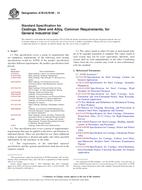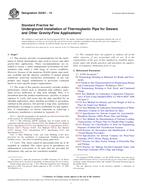1.1 This fire-test-response standard is applicable to door assemblies for use in walls to retard the passage of fire (see .).
1.2 This fire-test-response standard determines the ability of door assemblies to function as a fire-resistive barrier during a standard fire endurance test. Such a test meth shall not be construed as determining the suitability of door assemblies for continued use after their exposure to fire.
1.3 This fire-test-response standard is intended to evaluate the ability of a door assembly to remain in an opening during a predetermined test exposure, which when required by is then followed by the application of a hose stream (see ).
1.4 The hose stream test used in this test method is not designed to be representative of an actual hose stream used by a fire department during fire suppression efforts.
1.5 The fire exposure is not representative of all fire conditions, which vary with changes in the amount, nature, and distribution of the fire loading, ventilation, compartment size and configuration, and heat characteristics of the compartment. It does, however, provide a relative measure of fire endurance of door assemblies under specified fire exposure conditions.
1.6 Any variation from the tested construction or test conditions will possibly change the performance characteristics of door assembly.
1.7 This fire-test-response standard does not provide the following:
1.7.1 The fire endurance of door assemblies constructed of materials other than those tested.
1.7.2 A temperature limit on the unexposed surface of the door assembly, although the temperatures are measured and recorded.
1.7.3 A limit on the number of openings allowed in glazed areas or of the number and size of lateral openings between the door and frame.
1.7.4 A measurement of smoke or products of combustion that pass through the door assembly.
1.7.5 A measurement of smoke, toxic gases, or other products of combustion generated by the door assembly.
Note 1
The information in and may be important in determining the fire hazard or fire risk of door assemblies under actual fire conditions. This information may be determined by other suitable fire test methods. For example, flame spread and smoke development may be determined by Test Method E 84.
This standard does not purport to address all of the safety concerns, if any, associated with its use. It is the responsibility of the user of this standard to establish appropriate safety and health practices and determine the applicability of regulatory limitations prior to use.
1.8 This standard is used to measure and describe the response of materials, products, or assemblies to heat and flame under controlled conditions, but does not by itself incorporate all factors required for fire hazard or fire risk assessment of the materials, products, or assemblies under actual fire conditions
1.9 This test method references notes and footnotes which provide explanatory material. These notes and footnotes (excluding those in tables and figures) shall not be considered as requirements of this test method.
1.10 The values stated in either inch-pound units or SI units are to be regarded separately as standard. The values stated in each system may not be exact equivalents; therefore, each system shall be used independently of the other. Combining values from the two systems may result in nonconformance with the standard.
Product Details
- Published:
- 03/10/2000
- Number of Pages:
- 13
- File Size:
- 1 file , 140 KB


